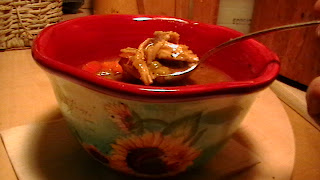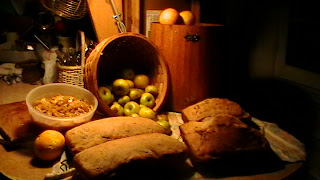After two days defrosting, a great bath and rub down with herb butter and a 12 hour soak in orange juice and bourbon, the turkey was finally ready to be stuffed and cooked.
 |
| Stuffing |
But before writing about that, I thought it a good idea to talk about the stuffing itself. As mentioned previously, I used a combination of breads made for a family dinner. These included Cornbread, Wheat/Oat and Walnut breads. After breaking the breads into pieces and adding dried spices and herbs (listed in previous blog entry), I let it cure in the pantry for a day so the bread could get a little stale. That's critical to good stuffing.
The night before the bird was to be stuffed, I chopped onions, celery and apples, browned them and added them to the bread. Next I browned some bulk sausage....guess where that went? After that, I took some of the basting juice made by simmering giblets, added some butter and poured it into the bread mixture. After mixing it around so that everything got a little of it, I recovered the stuffing and put it into the fridge for the final leg of its curing.
 |
| Good morning, Turkey |
 |
| Preparing roasting pan |
While all that rested I prepared the turkey pan - actually little more than a glorified lasagna pan- by first misting it inside with some release spray. Let's be honest, no matter how many layers of wrap you use to line it, that foil's gonna leak somewhere and pan drippings are bound to accumulate underneath. This step makes clean-up a lot easier. Nothing sticks!
Anyway, after that I lined the pan with aluminum foil -shiny side up-and coated it with release spray too. Then it was time for the brown paper.
 |
| Paper rubbed with herb butter |
"HOLD THE PHONE," I hear some saying, "Brown Paper?"
Yes. Brown paper is another very important element in this process. It is the defining difference between this recipe and any other version of making roast turkey. It is also how my mother and her mother before her did it. Roasting bags, aluminum foil, parchment....they all have their place, but to get a turkey that browns as it cooks but stays moist, there's nothing like a sheet of brown paper, greased on one side only with some of the herb butter, to make magic.
Once all that was ready, I came back to the turkey. I moved it near the sink, put on some plastic gloves and carefully opened the bag. A wonderful smell came forth. Citrus, spices, whiskey....a true bouquet!
 |
| Turkey coming out |
After reserving the marination liquid, I removed the plastic bag and discarded it then positioned the turkey so that smaller cavity could be filled.
First I rubbed it with some of the herb butter, then filled the space loosely with stuffing. Rather than sewing the turkey closed, I opted to simply fold the extra skin under. Because the stuffing was loose, it would be able to swell without causing undue pressure, so I didn't think the bird would spring much of a leak.
Before turning said turkey to its other side, I rubbed some herb butter on the underside and sprinkled it with some extra garlic, poultry seasoning and garlic. Then I flipped the bird....so to speak.
 |
| Stuffing the large cavity |
I repeated the herb butter rub, making sure to lift the skin over the breast and giving it a rub, too. I filled these pockets loosely
with stuffing, rubbed the cavity with herb butter and filled it too.
I'm never sure just how much to make, but as it turned out there was just enough stuffing for the job.
 |
| Ready for roasting! |
Rather than sew the front closed, I put half an orange in the opening, then crossed the legs over it and trussed them together with some thick thread. Then I transferred the turkey to its roasting rack in the specially prepared roasting pan, rubbed more herb butter on the breast, legs and wings (the parts that weren't tucked under). After a final spice sprinkling, I enveloped the turkey in its paper and put it in the 320 degree oven for about four and a half to five hours.
The beauty of this method is that you don't have to baste a lot. But I'd recommend about two to four bastings through the cooking time, and if your oven is slow like mine you might consider raising the oven temp by five to ten degrees. Also if your oven doesn't heat evenly make sure you turn the turkey a couple times during the roasting.
NOTE: Remember that when you open the oven door, you loose heat. So keep the openings to a minimum, keep 'em quick and make allowances in your cooking time for any time the door is opened for more than 3 minutes. Believe it or not, you can loose up to 100 degrees for each minute that door is open!
As time passed, the house filled with an incredible aroma! Sweet.....savory.....turkey!
 |
| Wylie T. Katz, turkey fanatic |
The cat kept coming into the kitchen every few moments, sniffing the air around the oven and licking his chops. Although we don't as a rule give Wylie table scraps, turkey is one of those things that he just absolutely loves....well, let's be honest - he's a turkey fanatic! So when it comes to the holiday meal we always give Mr. W a little treat.
He wouldn't have it any other way.
While the turkey cooked, I tended to lasts minute things. Jack wanted mashed potatoes, so that needed being done. But truth be told, they weren't to be "mashed," per se.
They were to be whipped with my trusty, ancient hand mixer-featured in an earlier blog entry.
But first, those spuds had to be cooked.
 |
| Whipped potatoes |
The potatoes went into the microwave after a thorough scrubbing, de-eyeing and slitting. Since there were 15 medium and small taters, I figured it would take about 15 minutes on HIGH to get the job done. I know there are folks who insist the only way to make mashed potatoes is to boil them after peeling.
That's a fine way to do it, too. I just like getting all the flavor and it's more accessible by baking, steaming or 'waving. Too many times veggies are "overboiled" and their tastiness gets lost to the boiling water. So if you do opt for this method, be careful.
Anyway.....
That underway, I ran down my check list. Beverages were chilling. Check. Cranberries chilling. Check.
The yams had been done the day before, so that just needed reheating. Check. The cole slaw was done and only needed to be set on the table. Check.
The table.....THE TABLE!!!!!
 |
| Jack set the table |
It was time for that to get done. Jack pulled the table out from behind some microphone stands and opened it out in the middle of our dining room/recording studio. I handed him one of his mother's wonderful table cloths and smiled as he pointed to the little china cabinet with our special dishes and offered to set the them 'round. What a sweet guy! Check!
I just sat down with a glass of sparkling cider when the oven timer chimed. Turkey time at last!
Both Jack and Wylie stood in the kitchen doorway as I opened the oven and liberated our main course from its dark, hot chamber. There was only one word to describe the aroma as I peeled the brown paper away from the golden brown bird....."succulent," or as Jack put it, "Mmmmmmmmmmmmmmmmmm."
 |
| Squeezing orange juice over turkey |
While the turkey rested, I put the yams and some of our home made dinner bread into the still hot oven for a bit of warming. I also put the bowl of potatoes in with a pat of butter on top of them, just to make sure they were warm too.
Then I drizzled orange juice over the resting bird, just for fun and double checked the meat thermometer.

It had been a perfect 180 degrees when first put up, and after sitting for fifteen minutes it was still within range. Time to carve and present. But first I grabbed a bowl and filled it with the stuffing. "Mmmmmmm" I heard from beneath me. Apparently the cat approved, too.
 |
| Carving the bird |
Carving was easy. First the legs and wings then the breasts. I didn't cut the whole thing down right then, we were all way too hungry for that!
So I covered the rest with a damp towel then a sturdy pan lid. The former to keep it moist, the latter to keep it away from Wylie. After that, everything was brought to the table and we sat down to eat with a prayer of hope for those who were not so fortunate as us, and a prayer of thanksgiving for all the blessings we've been given.
To say the least, the meal was fantastic-this according to both Jack and Wylie, and in truth I had to give it a thumbs up too.
Labor intensive? Completely! Time consuming? Absolutely!
Worth it? You betcha! But hey! If you've ever eaten a dry turkey you know how miserable it can be!
This turkey always comes out moist and flavorful....that's true of both the dark and white meat. This is a guaranteed moist turkey!
Please feel free to share your Turkey recipes here, and don't be afraid to try this recipe for yourself. Let me know any discoveries and modifications you make. I'm always anxious to learn more. Enjoy!






















































